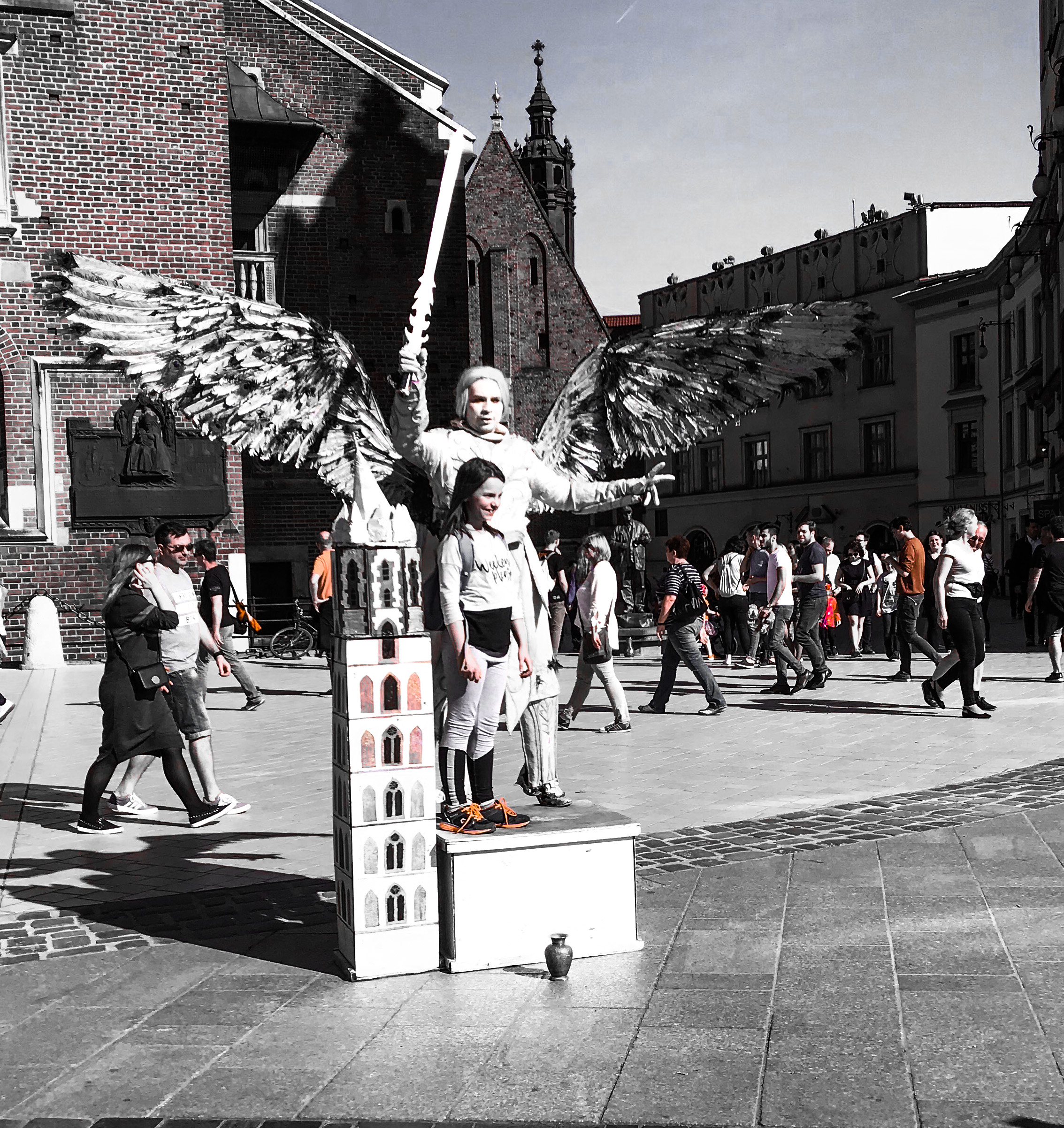The Love Affair with Cycling in Belgium and the Netherlands

As the temperature rose in Krakow, before we left for our trip to western Europe April 27, so did the number of bicyclists weaving in and out among pedestrians. My thoughts: I would not make it out of Krakow without getting hit by a bicyclist.
But the number of bicyclists in Krakow paled in comparison to western Europe, especially Amsterdam, where the sheer number of bikes zipping around me and front of me and back of me caused me to become obsessed that I wouldn’t make it out of Europe before being struck down by a crazed 20-something on her bike.
Number of bicycles owned per capita
Netherlands 1.3
Denmark .8
Japan .6
Belgium .5
Our food tour guide in Amsterdam had some interesting facts about bikes in the city and he peaked my interest to find out more about cycling in Netherlands and Belgium.

Delft, Netherlands
One person from our food tour group asked our guide: Why don’t children and adults wear helmets cycling? Tour guide’s response: We think helmets look silly and our streets and paths are cyclist friendly. If you see someone wearing a helmet, it’s an American.
(We were rerouted through downtown Brussels, Belgium by our GPS because of an accident on the highway around the city. Gotta love those electronics–everyone’s GPS must have rerouted the same route and it was insane–with bikes and cars. It was the first city where we saw a few helmets and they were mostly on the heads of males in business suits. With the amount of cars I imagine it was self preservation by Americans working in the financial district.)

Hague, Netherlands
Zachary Shahan in his article entitled “Why the Dutch don’t wear helmets” had observations from the Dutch.
You’re talking about the Netherlands, where helmet use is almost non-existent, bike use is very high, and yet it has the lowest cycling death and injury rate in the world.
If helmets really were effective, the USA would be the safest place to cycle, right?
…the Dutch don’t need bike helmets because cycling is not an intrinsically dangerous activity – it’s the road environment that is dangerous, and the Dutch have created a safe cycling environment.
As a Dutch I believe the best reason for not wearing helmets in the Netherlands is because it would discourage cycling (more then you can imagine in a country where cycling is not the main culture). You have to realize a lot of people (especially in the city and students) do everything on the bike. You’ll be going to a birthday, pick a quick present at the shop and continue to the address. A lot of people bike to work. Even going to a gala will be done on the bike. Helmets would totally ruin the hair :). Sounds simplistic, but it would be a practical reason to avoid the bike on a lot of occasions. Also: as you make so many trips, putting on your helmet on and of and carrying it with you all the time is quite the hassle.

Delft, Netherlands at an ATM
I agree that it is socially acceptable in the US to be aggressive to bicycles. I grew up in the Netherlands and have been in the US for eight years now.
In the Netherlands it has been socially unacceptable to use a mobile phone when driving for over a decade. In the US you even see police officers texting on their phone whilst driving. If I have a close call with a car it is almost always caused by the driver being on their phone. https://www.treehugger.com/bikes/why-dutch-dont-wear-helmets.htm

Delft, Netherlands
There are 7,800 official bike parking places near Amsterdam Central Station, but more than 8,200 bicycles are typically parked there.
I took the picture of Central Station in panorama view of just one of the bicycle parking areas near Central Station. Pictured are four levels of parking decks for bikes. Plans for the future include building a parking garage for 7,000 bikes under the waterfront.
On 21 August 2017 Utrecht’s newest bike parking facility will be officially opened…Currently there is room for 6,000 bikes. At the end of 2018 – when all the building work is to be completed – it will cater for 12,500 bikes, making it the largest bike parking facility in the world.
It’s not just the size of the building that’s unique. It’s also the first bike parking facility where you can cycle right in to find your parking place.
Parking is spread out over three levels. There is a separate section for season ticket holders and cargo bikes. There are also places allocated to bikes with crates and child seats that don’t fit in a regular bike rack. In the cellar you can rent one of the 720 brand new OV-bikes.
Price is no obstacle. The first 24 hours are free of charge, after that you pay only € 1,25 a day for a regular bike and € 1,50 for a non-standard size bike. To prevent valuable spaces from being taken up by abandoned bikes, bikes that have been left for longer than 2 weeks will be removed. http://www.holland-cycling.com/blog/285-world-s-largest-bike-parking-facility-now-open
The Dutch drive to push the car out of city centres began in the early 1970s, partly in response to the number of road deaths climbing to 3,300 – including 400 children. The success of the campaign is clear: the average Dutch person now cycles around 1,000km annually.
There are now 22.5 million bicycles in the Netherlands – more than the 17.1 million people who live there. More than a quarter of the country cycles to work. https://www.theguardian.com/world/2017/aug/07/worlds-biggest-bike-parking-garage-utrecht-netherlands

Amsterdam Central Station, Netherlands
Delft Central Station, Netherlands parking garage for bikes (room for 5,000 bikes)
Sixty-three percent of Amsterdammers over the age of 12 cycle daily.
We’d often see groups of school aged children and teens on what looked like school field trips. Searching the groups we never saw overweight children and my other unscientific observation is around 75% of girls (8 to 30’s) have long straight hair which blows in the wind as they pedal around or becomes drenched in the rain because hats seem to go the way of the helmets–no where.

I wish I had a picture of a mother riding with her children and groceries in the “tub” of this bike. There is even a plastic cover that attaches to keep them dry.
The Royal Belgian Cycling Association, as it was initially named, was founded in 1889 and it wasn’t long before cycling was the national sport in Belgium.
In Belgium and in the Flemish region in particular, the love of cycling borders on fanaticism. Whether it’s competitive or just for fun, takes place on the road, in a field or around the velodrome or “piste”,cycling catches the attention of any self-respecting Belgian.
Any excuse to pit man powered two wheel vehicle against man powered two wheeled vehicle is grabbed whatever the time of year. Every village seems to have a cycling club and most of these will meet once or twice a week for a 2½-hour ride that will usually cover 50 km or more.
Belgium is something of a paradise for the leisure cyclist and sometimes it seems that half the nation owns a (semi-) professional bike or even stables a selection of them in their garage, ready for any challenge on any terrain. If you thought the Dutch were born on a bike you have never visited Belgium. https://belgium.beertourism.com/about-belgium/cycling

Bruges, Belgium
Our tour guide said a common form of vandalism by juveniles in Amsterdam is to throw bikes in the canal and between 12,000 and 15,000 bicycles are pulled out of Amsterdam’s canals each year. Theft of bikes is common and around 100,000 bikes are stolen each year.
There are areas to buy used bikes around the city and it’s not unusual for riders to find their stolen bikes. Since used bikes are so cheap–they’ll just buy it back. He said most riders have two bikes. The commuter bike which they keep outside (likely to be stolen) and the bike they use for their longer weekend rides–newer and nicer–that they keep inside.


Most bikes are generic black, but a few are jazzed up.

Some have a bright colored front tires with black tires in the back.

Canal in Delft, Netherlands
In Bruges, Belgium visitors and residents can pay a ten euro membership fee and rent a bike for a year. The Flemish and local government want to be a pioneer in cycle culture. Every bicycle could equal one car less in the city center.
I did make it home from our trip unscathed by an untamed cyclist, but my closest call with my two-wheeled nemesis came from a female rider in Amsterdam. She’s still out there. Beware pedestrians!
As a disclaimer to this post, I own three bikes and until two years ago I cycled an average of 4-5 times a week. I actually love cycling and my daughter and family are cycling enthusiasts. She’s even on a women’s cycling team.

photo by Ben Freer




And if you think I’m exaggerating about cyclists watch this video made by some Amsterdammers. Enjoy!
About The Author
admin
Related Posts
Spring has sprung in and out Krakow
The mimes are out in the Main Square. The ermines are out. Outdoor…
May 11, 2018Without atmosphere a painting is nothing
For twenty years the Netherlands’ greatest artist Rembrandt Harmenszoon van Rijn lived and worked in…
May 11, 2018





Jess | 13th May 18
A whole post about cycling without mentioning us?!